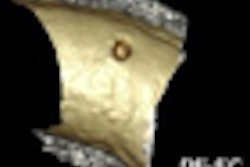A new processing method for conebeam CT images promises to dramatically lower radiation exposure for patients undergoing perfusion CT prior to image-guided radiation therapy (IGRT), according to a study presented at the American Association of Physicists in Medicine (AAPM) meeting in Philadelphia.
Conebeam CT plays an essential role in IGRT, which repeatedly scans patients during radiation therapy to precisely target tumors while minimizing radiation exposure to surrounding tissue. However, large cumulative radiation doses from the repeated scans are considered a drawback.
One way to lower dose is by simply reducing the total number of x-ray projections and mAs level, but the resulting images are noisy and data processing is slow. Fast reconstruction is a must for radiation therapy planning, said Xun Jia, PhD, from the University of California, San Diego in a statement accompanying the release of the study abstract.
The new CT reconstruction algorithm was based on recent advances in compressed sensing borrowed from graphics processing unit (GPU) platforms used in video games. Using GPU technology makes it possible to reconstruct a conebeam CT scan in about two minutes.
The researchers developed a fast GPU-based algorithm to reconstruct high-quality conebeam CT images from undersampled and noisy projection data in order to reduce radiation dose. With it, a total of 20 to 40 x-ray projections were sufficient to reconstruct images with satisfactory quality for image-guided radiation therapy, Jia and colleagues reported.
Reconstruction times ranged from 77 to 130 seconds on an Nvidia Tesla C1060 GPU card, depending on the number of projections used, an estimated 100 times faster than similar iterative reconstruction approaches.
"Our algorithm enables the [conebeam CT images] to be reconstructed under as low as 0.1 mAs/projection level," the researchers wrote. Use of the method achieved 36- to 72-fold dose reductions compared with currently available protocols employing as many as 360 projections.
"Our algorithm can also be used in [conebeam CT reconstructions] in limited-field-of-view scanning protocols for further reducing dose and in limited-angle scanning protocols for shortening scanning time," the authors wrote in their abstract.
If applied to diagnostic imaging, the method could reduce CT doses by a factor or 10 or more, wrote study co-author Steve Jiang, PhD.
By Eric Barnes
AuntMinnie.com staff writer
July 21, 2010
Related Reading
Wide-array CT reduces dose, improves images of thoracic aorta, July 7, 2010
ASIR halves VC dose without drop in image quality, June 21, 2010
Copyright © 2010 AuntMinnie.com



















